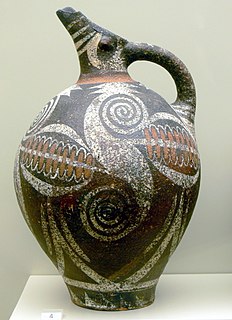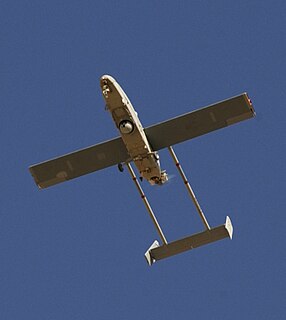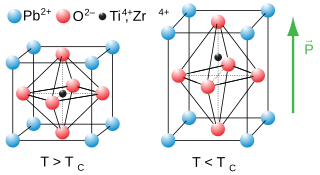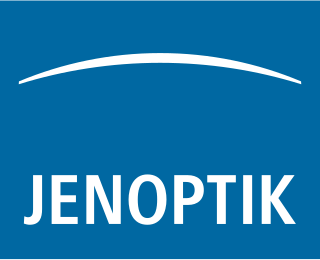
A ceramic is any of the various hard, brittle, heat-resistant and corrosion-resistant materials made by shaping and then firing a nonmetallic mineral, such as clay, at a high temperature. Common examples are earthenware, porcelain, and brick.

Piezoelectricity is the electric charge that accumulates in certain solid materials in response to applied mechanical stress. The word piezoelectricity means electricity resulting from pressure and latent heat. It is derived from the Greek word πιέζειν; piezein, which means to squeeze or press, and ἤλεκτρον ēlektron, which means amber, an ancient source of electric charge. French physicists Jacques and Pierre Curie discovered piezoelectricity in 1880.

Sonar is a technique that uses sound propagation to navigate, communicate with or detect objects on or under the surface of the water, such as other vessels. Two types of technology share the name "sonar": passive sonar is essentially listening for the sound made by vessels; active sonar is emitting pulses of sounds and listening for echoes. Sonar may be used as a means of acoustic location and of measurement of the echo characteristics of "targets" in the water. Acoustic location in air was used before the introduction of radar. Sonar may also be used for robot navigation, and SODAR is used for atmospheric investigations. The term sonar is also used for the equipment used to generate and receive the sound. The acoustic frequencies used in sonar systems vary from very low (infrasonic) to extremely high (ultrasonic). The study of underwater sound is known as underwater acoustics or hydroacoustics.

AAI Corporation is an aerospace and defense development and manufacturing firm, located in Hunt Valley, Maryland, US. Formerly a wholly owned subsidiary of United Industrial Corporation, AAI was acquired by Textron in 2007. It currently operates as a unit of Textron Systems and employs more than 2,000.

Lead zirconate titanate is an inorganic compound with the chemical formula Pb[ZrxTi1−x]O3 (0≤x≤1). Also called lead zirconium titanate, it is a ceramic perovskite material that shows a marked piezoelectric effect, meaning that the compound changes shape when an electric field is applied. It is used in a number of practical applications such as ultrasonic transducers and piezoelectric resonators. It is a white to off-white solid.

A piezoelectric motor or piezo motor is a type of electric motor based on the change in shape of a piezoelectric material when an electric field is applied. Piezoelectric motors use the converse piezoelectric effect of piezoelectric sensors, in which deformation or vibration of the piezoelectric material produces an electric charge. An electrical circuit makes acoustic or ultrasonic vibrations in the piezoelectric material, which produce linear or rotary motion. In one mechanism, the elongation in a single plane makes a series of stretches and position holds, analogous to the way a caterpillar moves.

A piezoelectric sensor is a device that uses the piezoelectric effect to measure changes in pressure, acceleration, temperature, strain, or force by converting them to an electrical charge. The prefix piezo- is Greek for 'press' or 'squeeze'.
A thin-film bulk acoustic resonator is a device consisting of a piezoelectric material manufactured by thin film methods sandwiched between two electrodes and acoustically isolated from the surrounding medium. FBAR devices using piezoelectric films with thicknesses ranging from several micrometres down to tenth of micrometres resonate in the frequency range of roughly 100 MHz to 20 GHz, . Any material like lead zirconate titanate (PZT) or barium strontium titanate (BST) from the list of piezoelectric materials could act as an active material in an FBAR resonator. However two compound materials aluminium nitride (AlN) and zinc oxide are the two most studied piezoelectric materials manufactured for high frequency FBAR realisations. This is due to the fact that the properties like stoichiometry of two compound materials can be easier to control compared to three compound materials manufactured by thin film methods. Despite of lower electromechanical coupling coefficient compared to zinc oxide AlN with a wider band gap has become the most used material in industrial applications, which require a wide bandwidth in signal processing. Compatibility with the silicon integrated circuit technology has supported AlN in FBAR resonator based products like radio frequency filters, duplexers, RF power amplifier or RF receiver modules. Thin film piezoelectric sensors may be based on various piezoelectric materials depending on the application, but two compound piezoelectric materials are favored due to simplicity of manufacturing.

Jenoptik is a German integrated photonics group that divides its activities into three photonics-based divisions Light & Optics, Light & Production and Light & Safety.
PCB Piezotronics is a manufacturer of piezoelectric sensors.

Ultrasonic transducers and ultrasonic sensors are devices that generate or sense ultrasound energy. They can be divided into three broad categories: transmitters, receivers and transceivers. Transmitters convert electrical signals into ultrasound, receivers convert ultrasound into electrical signals, and transceivers can both transmit and receive ultrasound.

Electromagnetic acoustic transducer (EMAT) is a transducer for non-contact acoustic wave generation and reception in conducting materials. Its effect is based on electromagnetic mechanisms, which do not need direct coupling with the surface of the material. Due to this couplant-free feature, EMATs are particularly useful in harsh, i.e., hot, cold, clean, or dry environments. EMATs are suitable to generate all kinds of waves in metallic and/or magnetostrictive materials. Depending on the design and orientation of coils and magnets, shear horizontal (SH) bulk wave mode, surface wave, plate waves such as SH and Lamb waves, and all sorts of other bulk and guided-wave modes can be excited. After decades of research and development, EMAT has found its applications in many industries such as primary metal manufacturing and processing, automotive, railroad, pipeline, boiler and pressure vessel industries, in which they are typically used for nondestructive testing (NDT) of metallic structures.

A piezoelectric accelerometer is an accelerometer that employs the piezoelectric effect of certain materials to measure dynamic changes in mechanical variables.

Ultrasonic machining is a subtractive manufacturing process that removes material from the surface of a part through high frequency, low amplitude vibrations of a tool against the material surface in the presence of fine abrasive particles. The tool travels vertically or orthogonal to the surface of the part at amplitudes of 0.05 to 0.125 mm. The fine abrasive grains are mixed with water to form a slurry that is distributed across the part and the tip of the tool. Typical grain sizes of the abrasive material range from 100 to 1000, where smaller grains produce smoother surface finishes.
In the field of industrial ultrasonic testing, ultrasonic thickness measurement (UTM) is a method of performing non-destructive measurement (gauging) of the local thickness of a solid element based on the time taken by the ultrasound wave to return to the surface. This type of measurement is typically performed with an ultrasonic thickness gauge.

Kistler Group, with headquarters in Winterthur, is an internationally active Swiss group of companies specializing in the field of measurement technology. With more than 30 Group Companies, the Kistler Group is represented at 61 locations in over 30 countries and, although owner-managed, is organized as a listed company. The Kistler Group employs some 2200 members of staff and generated revenue of 466 million Swiss francs in 2019. Approximately 10% of revenue flows back into research and technology every year.
Amplified piezoelectric actuators are specific actuators using piezoelectric materials as active material and have a specific design to overcome traditional limitations of classical direct piezoelectric actuators, the limited stroke. As classical piezoelectric materials have a strain of 0.1%, it is practically impossible to reach significant stroke without displacement amplification. The solution to reach middle range stroke is to use an amplification system.
A capacitive micromachined ultrasonic transducer (CMUT) is a relatively new concept in the field of ultrasonic transducers. Most of the commercial ultrasonic transducers today are based on piezoelectricity. CMUTs are the transducers where the energy transduction is due to change in capacitance. CMUTs are constructed on silicon using micromachining techniques. A cavity is formed in a silicon substrate, and a thin layer suspended on the top of the cavity serves as a membrane on which a metallized layer acts an electrode, together with the silicon substrate which serves as a bottom electrode.
Kenji Uchino is an American electronics engineer, physicist, academic, inventor and industry executive. He is currently a Professor of Electrical Engineering at Pennsylvania State University, where he also directs the International Center for Actuators and Transducers at Materials Research Institute. He is the former Associate Director at The US Office of Naval Research – Global Tokyo Office.












